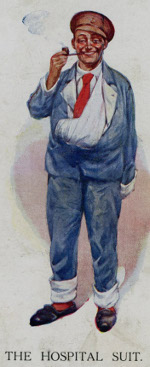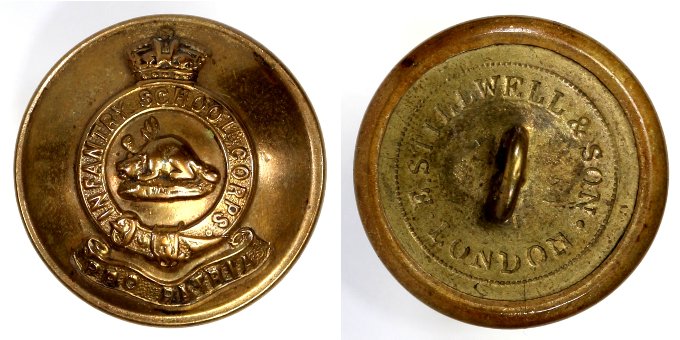Topic: CEF

The photo above shows an unidentified soldier of The Royal Canadian Regiment with a friend. Both men are wearing the standard dress for convalescing soldiers — Hospital Blues
During the First World War, many soldiers of the Canadian Expeditionary Force found themselves spending time in hospital. Diseases and injuries that today might be healed relatively quickly with batteries of antibiotics and other medicines to help the body combat infection could mean a hospital stay of week, or months, longer than we might envision under modern health care. Wounded and sick soldiers, depending on available facilities could find themselves recuperating not only in Hospital in France, but also throughout the United Kingdom. Especially, for the many which crossed the Channel as stretcher cases, their units administratively transferring them to holding units in the UK, there was not effective system (nor could there be one efficiently) that ensured a soldier would awake to find his own clean uniform to wear while convalescing.
 Instead, we find that widespread service was made of the British Amy's existing solution for clothing recuperating solders, the "hospital blues." Blue linen suits, lined in white and nattily accessorized with a bright red tie. What self-respecting soldier wouldn't find that outfit stylish and debonair for "walking out" during his convalescence, especially since they came in a range of few sizes fitting few soldiers well. Although originally cut to be buttoned to the neck, turning down the collar of the jacket added the benefit of bright white lapels to the hospital blues' appeal.
Instead, we find that widespread service was made of the British Amy's existing solution for clothing recuperating solders, the "hospital blues." Blue linen suits, lined in white and nattily accessorized with a bright red tie. What self-respecting soldier wouldn't find that outfit stylish and debonair for "walking out" during his convalescence, especially since they came in a range of few sizes fitting few soldiers well. Although originally cut to be buttoned to the neck, turning down the collar of the jacket added the benefit of bright white lapels to the hospital blues' appeal.
There was, however, one saving grace. Each soldier kept and wore his service cap and regimental badge with the hospital blues. This ensured they retained their regimental affiliations, and with discerning eye, could identify members of their own unit, or of ones they had fought with.
Soldiers might find themselves in "blues" for months at a time. The outfit also ensured that locals recognized the recovering soldier as such, and not mistaking him for someone they thought deserving of a white feather for ducking military service. The hospital suit garnered the respect due a man fighting for nation and Empire, even if the cause of his lengthy hospital stay might have been due to catching something his mother and minister would highly disprove of.
The greatest advantage of the blues was that while required to wear them, a soldier knew he was going to be sleeping in a warm bed, eating three square meals a day, and that his duty comprised getting fit enough to return to the fight.
More on Hospital Blues:
- Hospital Blues on the Great War Forum
- The ‘Convalescent Blues’ in Frederick Cayley Robinson’s ‘Acts of Mercy’


 (Or: "How One Regiment Could be Fighting in Three Places at Once")
(Or: "How One Regiment Could be Fighting in Three Places at Once") The Guide: A Manual for the Canadian Militia (Infantry)
The Guide: A Manual for the Canadian Militia (Infantry)




 Equipment
Equipment


 We can also most likely expect to see the recurrence of another trend that has followed major commemorations of Canada's wars overseas, a tendency for many Canadians to be reminded that they too had family members who fought and, for some, family members who did not return home. Some will begin a journey of discovery to see what can be learned of those grandfathers, great-uncles, and other relatives, many of whom left little to the family history but the gaps their loss or silence created.
We can also most likely expect to see the recurrence of another trend that has followed major commemorations of Canada's wars overseas, a tendency for many Canadians to be reminded that they too had family members who fought and, for some, family members who did not return home. Some will begin a journey of discovery to see what can be learned of those grandfathers, great-uncles, and other relatives, many of whom left little to the family history but the gaps their loss or silence created.
 We often hear catchphrases but we can never quite be certain where they originated. Infantry officers training in the Canadian Army have long head one which goes "Time spent on recce (i.e, reconnaissance) is never wasted" … intending to teach the new officer that even if he or she thinks they understand a situation completely, a thorough reconnaissance (time permitting) is invaluable, if for no other reason to confirm what is known. Inevitably, in training and service afterwards, reconnaissance often identified factors that were previously not known to the officer and which materially affect the plan evolving in their mind. failing to heed this adage can have serious consequences.
We often hear catchphrases but we can never quite be certain where they originated. Infantry officers training in the Canadian Army have long head one which goes "Time spent on recce (i.e, reconnaissance) is never wasted" … intending to teach the new officer that even if he or she thinks they understand a situation completely, a thorough reconnaissance (time permitting) is invaluable, if for no other reason to confirm what is known. Inevitably, in training and service afterwards, reconnaissance often identified factors that were previously not known to the officer and which materially affect the plan evolving in their mind. failing to heed this adage can have serious consequences.


 Not all Battle Honours are equal in terms of the scale of action for which they were awarded. Some cover vast expanses of terrain and months or years of warfare, while others are defined by single dates and very restrictive geographical boundaries. When we look at the list of honours awarded to a regiment we may find Battle Honours that range from Theatre Honours to Separate Actions or Engagements.
Not all Battle Honours are equal in terms of the scale of action for which they were awarded. Some cover vast expanses of terrain and months or years of warfare, while others are defined by single dates and very restrictive geographical boundaries. When we look at the list of honours awarded to a regiment we may find Battle Honours that range from Theatre Honours to Separate Actions or Engagements.


 During the First World War,
During the First World War, 

 The Guide: A Manual for the Canadian Militia (Infantry); Compiled by Major-General Sir William D. Otter, K.C.B., C.V.O. (retired List) – Ninth Edition—Revised 1914
The Guide: A Manual for the Canadian Militia (Infantry); Compiled by Major-General Sir William D. Otter, K.C.B., C.V.O. (retired List) – Ninth Edition—Revised 1914
 Thus reads the opening paragraphs of the chapter covering the battle of
Thus reads the opening paragraphs of the chapter covering the battle of 

 With stereotypical military attention to detail, the 1951 Canadian Army Manual of Training for Drill for all arms details the two fundamental physical movements which will comprise much of a drill instructor's attention and verbal repertoire when teaching new recruits:
With stereotypical military attention to detail, the 1951 Canadian Army Manual of Training for Drill for all arms details the two fundamental physical movements which will comprise much of a drill instructor's attention and verbal repertoire when teaching new recruits:


 Twenty years ago, the Canadian Army, following Government direction, stopped smoking indoors. It may seem strange to many today who are too young to remember those days, but smoking was such an ingrained part of Canadian culture at the time that every office, every barrack room and every table in the messes featured an ashtray. Even for those who didn't smoke, the ready access to an ashtray needed to be provided for the many who did and expected the courtesy. Few items were more iconic than the ubiquitous round ashtrays in brown glass that were provided through the Canadian Forces Supply System, often seen overflowing with butts on the desks of heavy smokers.
Twenty years ago, the Canadian Army, following Government direction, stopped smoking indoors. It may seem strange to many today who are too young to remember those days, but smoking was such an ingrained part of Canadian culture at the time that every office, every barrack room and every table in the messes featured an ashtray. Even for those who didn't smoke, the ready access to an ashtray needed to be provided for the many who did and expected the courtesy. Few items were more iconic than the ubiquitous round ashtrays in brown glass that were provided through the Canadian Forces Supply System, often seen overflowing with butts on the desks of heavy smokers.

